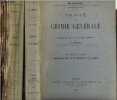8 books for « nernst w »Edit
-
Topics
Chemistry (6)
Einstein (1)
Law (1)
Mathematics (1)
-
Countries
Denmark (5)
France (3)
-
Syndicate
ILAB (6)
SLAM (1)
Traité de chimie générale. Ouvrage traduit sur la 6e édition allemande par A. Corvisy -- PREMIERE EDITION FRANCAISE -- 2 VOLUMES -- VOLUME 1 : PROPRIETES GENERALES DES CORPS - ATOME ET MOLECULE - VOLUME 2 : TRANSFORMATIONS DE LA MATIERE ET DE L'ENERGIE -- COMPLETE SET
P., Hermann, 1911-1912, 2 VOLUMES in 8 reliés en demi-basane noire (reliure de l'époque), (cachets de bibliothèque), T.1 : (2), 2pp., 510pp., T.2 : (2), 422pp.
---- PREMIERE EDITION FRANCAISE du traité de Nernst paru sous le titre Theoretische Chemie vom Stanpunkte der Avogadroschen Regel... ---- EXEMPLAIRE BIEN COMPLET DES DEUX VOLUMES COMPOSANT CE TRAITE ---- "Although NERNST's early worldwide reputation resulted from a broad range of fundamental contributions to the new developments in physical chemistry, especially in electrolytic solution theory, his crowning achievement was in chemical thermodynamics. For this work NERNST received the Nobel Prize for chemistry in 1920... During the early Göttingen period of his career, NERNST's conception of the goals and significant advances in theoretical chemistry was fashioned and published in his Theoretische Chemie. This textbook was dedicated to Ettingshausen in Graz. As NERNST conceived it, the most important of chemical processeses was first, to recognize the central importane of AVOGRADO's hypothesis and second to accentuate the law of energy that governs all natural processes. Convinced that theoretical chemistry had begun to attain a certain maturity, NERNST feld that an independent textbook was needed in order to bring together widely different aspects of physics and chemistry... As he indicated in the preface, his objective was to present the latest investigation... In Germany until 1926 this work was recognized as the foremost textbook of physical chemistry...". (DSB Suppl. pp. 432/452) ---- - Partington IV pp. 633/636**3857/CAV.E1
Theoretische chemie vom standpunkte der Avogadroschen regel un der thermodynamik
Stuttgard, Enke, 1926, un fort volume in 8 relié en cartonnage éditeur, (cachets de bibliothèque), 16pp., 927pp., figures dans le texte
---- Quinzième et dernière édition ---- "Although NERNST's early worldwide reputation resulted from a broad range of fundamental contributions to the new developments in physical chemistry, especially in electrolytic solution theory, his crowning achievement was in chemical thermodynamics. For this work NERNST received the Nobel Prize for chemistry in 1920... During the early Göttingen period of his career, NERNST's conception of the goals and significant advances in theoretical chemistry was fashioned and published in his Theoretische Chemie. This textbook was dedicated to Ettingshausen in Graz. As Nernst conceived it, the most important of chemical processes was first, to recognize the central importance of AVOGADRO's hypothesis and second to accentuate the law of energy that governs all natural processes. Convinced that theoretical chemistry had begun to attain a certain maturity, NERNST field that an independent textbook was needed in order to bring together widely different aspects of physics and chemistry... As he indicated in the preface, his objective was to present the latest investigation... In Germany until 1926 this work was recognized as the foremost textbook of physical chemistry...". (DSB Suppl. pp. 432/452)**38590/3859/CAV.E3
EINSTEIN, ALBERT. - ON PLANCK'S RADIATION LAW AND NERNST'S THERMODYNAMICAL LAW.
Reference : 48163
(1914)
Beiträge zur Quantentheorie"
Braunschweig, Vieweg & Sohn, 1914. No wrappers. ""Verhandlungen der Deutschen Physikalischen Gesellschaft im Jahre 1914. Hrsg. von Karl Scheel."", 16. Jahrgang, Nr. 16. Pp. (765-) 834. (Entire issue offered). With the general titlepage to 16. Jahrg. Titlepage stamped at foot. Einstein paper pp. 820-828.
First edition. In this paper ""Contributions to quantum theory"" two considerations are given which are interrelated by a common goal, inasmuch as it is attempted to derive two of the most importent achievementss of quantum theory, viz. Planck's radiation law and Nernst's third law of thermodynamics, in a new manner. The proofs do not involve Boltzmann's equation and are thus based enterely on macroscopic thermodynamics. They do introduce, however, the quantum hupothesis. (Einstein points out that the alleged 'proofs' which try to derive the theorem of Nernst from the mere fact that the heat capacity of all substances goes to zero at absolute zero temterature, are not genuine). (Cornelius Lanczos).Weil No 67.
Traité de chimie générale, Tome 1 + 2 - Tome 1: Propriétés générales des corps - Atome et molécule - Tome 2: Transformations de la matière et de l'énergie (2 volumes).
Hermann et Fils. 1911-1912. In-8. Broché. Etat d'usage, Tâchée, Dos plié, Papier jauni. 510 + 422 pages, nombreux tableaux et graphiques dans le texte - coins frottés, coiffes abimées, Tome 1 partiellement désolidarisé dont le 2e plat est désolidarisé, mouillures sur le 2e plat et quelques pages ne génant pas les lecture du Tome 1, rousseurs sur les plats.. . . . Classification Dewey : 540-Chimie et sciences connexes
Traduit par A. Covisy. Classification Dewey : 540-Chimie et sciences connexes
Einführung in die mathematische Behandlung der Naturwissenschaften. Mit 68 im Text befindlichen Figuren. Dritte Auflage.
München & Leipzig, Wolff, 1901. Contemp. hcalf. XII,340 pp., textillustr.
Third edition of the famous textbook which by 1931 had passed through 11 editions.
Theoretische Chemie vom Standpunkte der Avogadroschen Regel und der Thermodynamik. Achte bis Zehnte Aufl. Stuttgart, Enke, 1921.
Lex8vo. Private full cloth. XVI,896 pp.
Theoretische Chemie vom Standpunkte der Avogadroschen Regel und der Thermodynamik. Siebente Aufl.
Stuttgart, F. Enke, 1913. Lex8vo. Orig. full cloth. Spine ends somewhat worn and top torn. XVI,838 pp., textillustr.
Theoretische Chemie vom Standpunkte der Avogadroschen Regel und der Thermodynamik. Achte bis Zehnte Auflage. Mit 58 in den text gedruckten Abbildungen.
Stuttgart, Ferdinand Enke, 1921. Lex8vo. Orig. full cloth. Back faded and inner hinge a bit loose, not broken. XVI,896 pp.
 Write to the booksellers
Write to the booksellers



